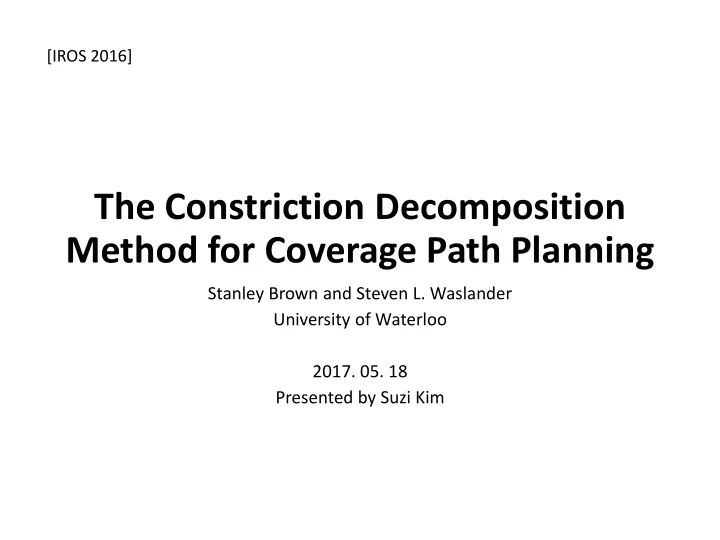

[IROS 2016] The Constriction Decomposition Method for Coverage Path Planning Stanley Brown and Steven L. Waslander University of Waterloo 2017. 05. 18 Presented by Suzi Kim
Errors in Equations Errors in Algorithm Poor Explanation Lack in Experiments
THEN, WHY TO PRESENT THIS PAPER?
1. No recent paper dealing with the topic “Coverage Path Planning on 2D Map”
2. Coverage path planning with topological analysis is quite interesting.
Coverage Path Planning (CPP) • Determining a path that passes over all points of an area while avoiding obstacles. • Generally, using back and forth motion after cell decomposition. • Ex) Vacuum cleaning robots, painter robots, autonomous underwater robots, lawn mowers, automated harvesters
CPP implies Space Efficiency Maybe no direct relation. At least weak relation…!
The Constriction Decomposition Method for Coverage Path Planning
[Previous Work] Trapezoidal Decomposition http://user.ceng.metu.edu.tr/~akifakkus/courses/ceng786/hw3.html
[Previous Work] Boustrophedon Decomposition http://user.ceng.metu.edu.tr/~akifakkus/courses/ceng786/hw3.html
Why Less Cells Are Better? Disturb the exact length Galceran, Enric, and Marc Carreras. "A survey on coverage path planning for robotics." Robotics and Autonomous Systems , 2013
Constriction Decomposition Method
Constriction Decomposition Method 1. Generate a Straight Skeleton. 2. For all split nodes, Generate a separator from a neighbor node of split nodes on boundary.
Constriction Point = Split Node Straight Skeleton
Constriction Point <Shrinking Process> = Split Node Straight Skeleton Aichholzer, Oswin , et al. "A novel type of skeleton for polygons.“, 1996. Felkel, Petr, and Stepan Obdrzalek. "Straight skeleton implementation .“, 1998.
Split Event
Edge Event
If the polygon is decomposed based on the split nodes in its straight skeleton, It is possible to create a set of cells that have no split nodes in their straight skeletons.
[Coverage Path Planning] [1] [2] [3] Constriction Cell Cell Decomposition Visitation Coverage Method Order Paths
[2] Cell Visitation Order • Should visit every cell. • Generate an augmented adjacency graph. • Solve using a Heuristic TSP algorithm.
[3] Cell Coverage Paths • Applying Boustrophedon Decomposition to non- convex polygon directly might lead to over decomposition depending on the incline of the scan line.
[3] Cell Coverage Paths 1. Spiraling until the remaining free space forms a convex shape. 2. Generating Boustrophedon paths for the remaining convex shape area.
Results Environment BSD CDM Improvement Non-convex 3 3 0% Non-convex, with holes 1 14 9 36% Non-convex, with holes 2 11 3 73% Non-convex, with holes 3 9 5 44% Floor Plan 1 169 53 68% Floor Plan 2 158 65 58% Floor Plan 3 172 66 62% BSD: Boustrophedon Decomposition CDM: Constriction Decomposition Method
Results Environment BSD CDM Improvement Non-convex, with holes 1 14 9 36%
Results Environment BSD CDM Improvement Floor Plan 1 169 53 68%
Conclusion • Strength in complex indoor environments containing lots of hallways and rooms. • Doubt in ‘ Cell Coverage Paths ’ whether it is really better than using either of spiraling or Boustrophedon paths.
Recommend
More recommend